


|
1783 |
Catherine the Great of
Russia seizes the Crimea. This leads to the Russo-
|
|
1784 |
In India, the Treaty of Mangalore
ends the Second Anglo-
The puddling process, introduced by the Englishman Henry Cort, revolutionises the manufacture of wrought iron and gives a further boost to the Industrial Revolution.
Jacques-
|
|
1785 |
The Scottish geologist James Hutton
puts forward his idea -
|
|
1786 |
Because of its strategic and commercial value, the British East India Company establishes a colony on Penang, a small island off the coast of Malaya in the Strait of Malacca.
The Austrian musical genius Wolfgang Amadeus Mozart composes his world famous opera The Marriage of Figaro. He wrote a vast wealth of sacred and secular music.
The Kilmarnock edition of his early poems brings lasting fame to the Scottish poet Robbie Burns. A poetic genius in his native language, his major work was Tam O’Shanter.
The Frenchmen Michel Paccard and Jacques Balmat become the first men to climb Mont Blanc, Europe’s highest mountain. The Swiss scientist Horace Saussure climbs it in 1787.
|
|
1787 |
A Convention at Philadelphia draws up the constitution of the United States, a written document which establishes a federal government within a republic. It is passed in 1788.
The brilliant French
chemist Antoine Lavoisier (1777 G3a)
publishes his Method of Chemical Nomen- He is guillotined in 1794. |
|
1788 |
The British captain Arthur Phillip arrives off Botany Bay, New South Wales, with 760 convicts, and sets up the first penal settlement in Australia on the site of modern Sydney.
The French naturalist Georges Buffon dies, having completed 36 volumes of his treatise on Natural History (discussed 1767 G3a). His assistants complete the final 8 volumes by 1804.
France becomes bankrupt. Political unrest grows throughout the country and Louis XVI is forced to recall the States General, a body made up of nobility, clergy and commoners.
The English historian Edward Gibbon completes his masterpiece, The Decline and Fall of the Roman Empire, a work which ranks as one of the world’s greatest history books.
The Italian-
|
|
1789 |
George Washington is elected the first President of the United States. The city named after him in the District of Columbia becomes the seat of government the following year.
Mutiny breaks out aboard HMS Bounty. Captain Bligh and 18 members of his crew are set adrift in an open boat in the South Seas. The mutineers settle on Pitcairn and Tahiti.
In July, the French Revolution opens with the storming of the Bastille prison in Paris. Work begins on the Declaration of the Rights of Man, but the country seethes with unrest.
The English philosopher and social reformer Jeremy Bentham publishes his Principles of Morals and Legislation, the work in which he sets out his doctrine known as Utilitarianism.
|
|
1790 |
The English statesman Edmund Burke denounces the revolution in his Reflections on the Revolution in France. It is countered in 1791 by Thomas Paine’s The Rights of Man.
The English furniture designer Thomas Sheraton arrives in London. The following year he begins the publication of his influential The Cabinet Maker and Upholsterers’ Drawing Book.
The leading British cartographer Aaron Arrowsmith establishes his reputation with his first map of the world. The country’s Ordnance Survey was founded the following year. |
|
1791 |
In France, Louis XVI, after reluctantly
agreeing to a constitutional monarchy, tries to flee the
country -
James Boswell, one of the
greatest of English biographers, publishes his Life
of Samuel Johnson. He first met the English man of
letters in 1763 and remained a life-
The west coast of Canada is surveyed by the English explorer George Vancouver, whilst, in the east, the Constitutional Act is passed, dividing the colony of Quebec into two parts.
The Austrian composer Franz Joseph Haydn, the father of the symphony and founder of the string quartet, arrives in England and begins work on his twelve London Symphonies.
The negro Toussaint Louverture leads a slave rebellion in the French colony of Saint Domingue. He dies in prison in 1803, but the French are forced to leave the following year.
|
|
1792
1793 |
By the Treaty of Jassy, ending the war between Russia and Turkey begun in 1787, the Russians finally gain unrestricted access to warm water ports in the Black Sea.
The English radical thinker Mary Wollstonecraft publishes her Vindication of the Rights of Woman, calling for a system of education which would enhance their natural abilities.
The English politician and humanitarian William Wilberforce persuades Parliament to agree to the gradual abolition of the slave trade, but it takes another fifteen years to be official.
In France the King, Louis XVI, and his wife, Marie Antoinette, are executed by guillotine and a Reign of Terror begins against the aristocracy and anyone opposing the new Republic.
The American inventor Eli Whitney perfects a “cotton gin” for cleaning cotton fibre. Enabling one man to do the work of 200, it greatly increases cotton production in the South.
A trade mission to China
by Lord Macartney ends in failure.
The Emperor Ch'ien-
|
|
1794 |
The execution of Danton, followed by that of Robespierre, ends the Reign of Terror. Some 17,000 men and women were executed throughout France, the majority by the guillotine.
The German poet, dramatist and historian Friedrich Schiller begins his long friendship with Goethe. Over the next ten years he produces some of his finest dramas, including Wallenstein, Joan of Arc and William Tell.
The English mystic poet
and artist William
Blake completes his Songs
of Experience, a work which includes the famous poem
which begins:-
|
|
1795 |
By the Treaties of Basle the French republic makes peace with Prussia, Holland, Sweden and Spain. Uprisings are put down and The Directory takes over the government of France.
In South Africa, the British seize Cape Settlement from the Dutch and, in the Indian Ocean, begin the occupation of Sri Lanka, taking over the Dutch island the following year.
The Scottish explorer Mungo Park starts to trace the course of the Niger (Black) River in West Africa. He makes some progress, but is killed in 1806 during a second expedition.
Methodism in England, formed mainly by the endeavours of John Wesley as from the 1730s, breaks away from the established church and becomes an independent movement.
Following the third partition, Poland is finally swallowed up by her powerful neighbours, Russia, Prussia and Austria. The Polish nation is not restored until 1918, 123 years later.
Making his first public appearance in Vienna, the German composer Ludwig van Beethoven plays one of his early concertos.The first of his great symphonies is produced in 1803 (G3c).
|
|
1796 |
|
|
1797 |
The British defeat a
Franco-
By the Treaty of Campo Formio, achieved by the victories of General Bonaparte, Austria cedes to France its lands in Belgium and Italy, and German territory up to the Rhine.
|
|
1798 |
A rebellion for Irish independence, led by the Society of United Irishmen, is crushed at the Battle of Vinegar Hill. This revolt leads to the union of Ireland and Great Britain in 1801.
General Bonaparte, abandoning an invasion of England, strikes at Britain by invading Egypt. He captures Cairo after defeating the Egyptians at the Battle of the Pyramids.
The British admiral Horatio Nelson destroys the French fleet at the Battle of Aboukir Bay, ending French designs in the Middle East and leaving their army stranded in Egypt.
In his Essay on the Principles of Population the English economist Thomas Malthus predicts that, in time, the world will be unable to support its growing population.
|
|
1799 |
In India, the Anglo-
A new coalition of nations is formed to contain the French, but it argues over strategy. Napoleon Bonaparte, returning from Egypt, seizes power in The Consulate.
|
|
1800 |
Napoleon defeats the Austrians at the Battle of Marengo, north of Genoa. The Second Coalition collapses and France regains northern Italy by the Treaty of Luneville (1801). The Italian physicist Alessandro Volta devises a rudimentary battery known as a “voltaic pile”. His name was later given to the volt, a unit of electromotive force.
|
|
1801 |
Admiral Sir Hyde Parker destroys the Danish fleet at the Battle of Copenhagen. Lord Nelson leads the attack and, ignoring a command to withdraw, wins a crushing victory.
The American inventor Robert Fulton produces the Nautilus, the first practical submarine. In 1807 (G3c) his steamboat, the Clermont makes its maiden voyage on the Hudson River.
ThexGerman astronomer Johann Bode publishes Uranographia, the first atlas to show all the stars visible to the naked eye. This work greatly increases public interest in astronomy.
|
|
1802 |
The Treaty of Amiens provides a breathing space in the struggle between Britain and revolutionary France. But the battles of the Napoleonic Wars are soon to come (G3c).
|







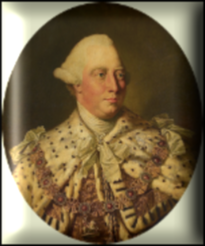 The loss of the American colonies, confirmed
by the Peace of Paris in 1783, was a humiliation for the British
government and, in equal measure, for the British king. Though not,
perhaps, the autocratic monarch his opponents (particularly the Whigs)
would have him painted, George III was nevertheless a powerful force
in politics in the first twenty years of his reign. Via his
parliamentary “friends”, led by his chief minister
The loss of the American colonies, confirmed
by the Peace of Paris in 1783, was a humiliation for the British
government and, in equal measure, for the British king. Though not,
perhaps, the autocratic monarch his opponents (particularly the Whigs)
would have him painted, George III was nevertheless a powerful force
in politics in the first twenty years of his reign. Via his
parliamentary “friends”, led by his chief minister 1801, however, his disability did not prevent him from entering once
more into the political arena, this time in respect of Ireland.
Following a rebellion in favour of Irish independence, eventually
crushed at the Battle of Vinegar Hill in 1798, Pitt came to the
conclusion that a merging of the two parliaments was the most
promising means of preventing further trouble. He steered the Act of
Union through parliament in 1801, but his aim to give full civil
rights to Roman Catholics -
1801, however, his disability did not prevent him from entering once
more into the political arena, this time in respect of Ireland.
Following a rebellion in favour of Irish independence, eventually
crushed at the Battle of Vinegar Hill in 1798, Pitt came to the
conclusion that a merging of the two parliaments was the most
promising means of preventing further trouble. He steered the Act of
Union through parliament in 1801, but his aim to give full civil
rights to Roman Catholics - Almost
the entire twenty years of this middle period of George III’s reign
was dominated by the French Revolution and the Revolutionary Wars it
spawned. At first there was some marked support in Britain for the
aspirations of the French revolutionaries, and security at home had to
be tightened, but following the execution of Louis XVI in 1793, the
Reign of Terror, and the beginning of the Revolutionary Wars, the king
became, in fact, a symbol of national resistance. Already an object of
sympathy on account of his illness, and the unseemly behaviour of his
son, the Prince of Wales, the old king now became a father figure and
the guardian of the country’s freedom. And his prestige, enhanced by
Nelson’s victories at the Battles of the Nile and Copenhagen, was to
reach greater heights during the triumphs achieved by his countrymen
during the Napoleonic Wars
Almost
the entire twenty years of this middle period of George III’s reign
was dominated by the French Revolution and the Revolutionary Wars it
spawned. At first there was some marked support in Britain for the
aspirations of the French revolutionaries, and security at home had to
be tightened, but following the execution of Louis XVI in 1793, the
Reign of Terror, and the beginning of the Revolutionary Wars, the king
became, in fact, a symbol of national resistance. Already an object of
sympathy on account of his illness, and the unseemly behaviour of his
son, the Prince of Wales, the old king now became a father figure and
the guardian of the country’s freedom. And his prestige, enhanced by
Nelson’s victories at the Battles of the Nile and Copenhagen, was to
reach greater heights during the triumphs achieved by his countrymen
during the Napoleonic Wars  The
French balloonist ,
The
French balloonist , 
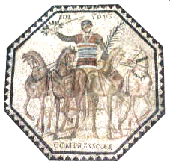 The
German philosopher
The
German philosopher 
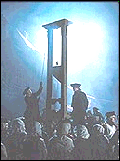 The
Austrians and Prussians invade France, but are defeated at the
The
Austrians and Prussians invade France, but are defeated at the
 The
first Japanese artist to become well-
The
first Japanese artist to become well- The
English doctor
The
English doctor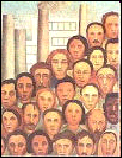 The
English poet
The
English poet  The
The
